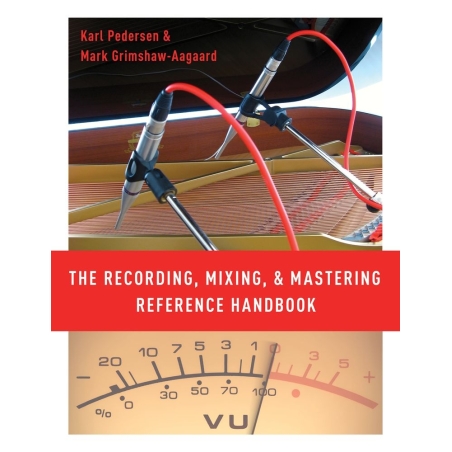The Recording, Mixing, and Mastering Reference Handbook provides an easy-to-read guide for music-making in the studio setting, from equipment fundamentals to recording and mixing almost any instrument.
CONTENTS
About the Companion Website
Introduction
PART I The Instruments (practical recording and mix-techniques)
Chapter 1 The Voice
Acoustics and microphone settings DT Vocal psychology DT The Headphone Mix DT Tips DT Various vocal techniques DT The mix settings and effects DT Special uses of vocal microphones DT Harmony vocals as overdub DT Tips
Chapter 2 The Drum Kit
The Instrument and the acoustics DT Mic setup DT Mic technique: The individual drums in the kit DT Advanced mic setups DT Mix-settings and effects
Chapter 3 The Bass Guitar
The instrument DT Mic or DI? DT Or both? DT Virtual amps DT Mix-settings and effects DT Tips
Chapter 4 The Electric Guitar
The instrument DT Mic techniques DT Ambience and acoustics DT Layering guitars DT Virtual stacks & re-amping DT Mix-settings and effects DT Tips
Chapter 5 The Piano
The Instrument and the acoustics DT Always use condenser microphones DT Recording acoustic pianos in the studio DT Digital piano DT Live recording DT Mix-settings and effects
Chapter 6 The Acoustic Guitar
The Instrument DT Mic setup DT Mix-settings and effects
Chapter 7 The Recording of Some Less Common String Instruments
The mandolin DT The dobro DT The banjo DT The harp
Chapter 8 Percussion
Congas and bongos DT Cajon DT Claves DT Djembe and bodhran DT Tambourine and shakers DT Timbales DT Xylophone, marimba, vibraphone, and glockenspiel
Chapter 9 The Double Bass and the 'Cello
The Instrument and the acoustics DT Mic setup DT Stereo setups DT Mix-settings and effects DT Tips
Chapter 10 The Violin and the Viola
The Instrument and the acoustics DT Mix-settings and Effects DT Tips
Chapter 11 Brass and Wind Instruments
Brass and saxophones DT The horn section DT The flute DT Tips
Chapter 12 Synthesizers and Electronic Keyboards
The instrument DT DI, mics, or MIDI DT Mix-settings and effects DT Tips
Chapter 13 The Leslie Speaker
The Instrument DT Mic setup DT Mix-settings and effects
Chapter 14 Live in the Studio
Isolation booths and screens DT Ghost Notes DT Tips
Chapter 15 Recording Choirs and Small Acoustic Ensembles
The acoustics DT Mic placement DT Spot mics DT Tips DT Choirs with accompaniment DT Mix and editing
PART II Microphone Techniques (principles/background theory)
Chapter 16 Microphones: Types and Specifications
The transducer types DT Reading mic specifications DT Comparing Mics
Chapter 17 Microphones: Polar Pattern
Cardioid DT Omni DT Figure-of-eight DT Multi-pattern microphones DT Shotgun microphones DT Mic techniques DT Omni v. cardioid: Choosing the right polar pattern DT Recording with omnis
Chapter 18 Stereo Recording
Spaced omni - The Decca tree - Baffled stereo DT Coincident stereo DT MS Stereo DT More stereo setups: ORTF, NOS stereo, & binaural DT
PART III Processors and Effects (principles and practice)
Chapter 19 EQ and Instruments
Sub bass (20-60 Hz) DT Bass (60-250 Hz) DT Low-mid (250 Hz to 2 kHz) DT Midrange (2-4 kHz) DT High-mid (4-6 kHz) DT High (6-20 kHz) DT The components of the EQ DT Common types of EQ DT EQ'ing different instruments - use your ears and your imagination DT Complementary EQ and contrasting frequency ranges DT The graphic EQ DT Tips
Chapter 20 Harmonics and EQ
The Harmonic Series DT EQ'ing harmonics
Chapter 21 Compressor/Limiter and Expander/Gate
Compressor DT Gate and Expander
Chapter 22 History of the Reverb
Natural ambience DT Electronic reverbs DT EMT 140 Plate Reverb DT EMT 250 goes digital
Chapter 23 Tape Echo and Digital Delay
Tape echo DT Digital delay DT Calculating delay time DT Using delays DT Tips
Chapter 24 Ambience and Reverb
Digital reverbs in the studio DT The parameters of the digital reverb DT Insert or send DT Reverb-types DT How to use reverb DT Tips
Chapter 25 Convolution Reverb
Impulse response (IR) DT IR libraries DT Special FX DT How to create an IR DT Tips for recording an IR
Chapter 26 Modulation Effects
Flanging DT Chorus DT Phase shift DT The Haas Effect and doubling DT Tips
Chapter 27 Distortion and Tape Saturation
Enhancing sounds with distortion DT Tape saturation DT Distortion used as an effect DT Tips
Chapter 28 Varispeed and Pitch Processors
Pitch shift DT Pitch Correction DT Manipulating sound with pitch processors
PART IV Mixing and Mastering (principles and practice)
Chapter 29 The Mix
The basic mix DT Utilizing the stereo field DT EQ DT Depths and widths DT The sound stage DT Make the individual tracks on the mix sparkle - EQ revisited DT Stereo groups DT Compression DT Leave a little headroom to the mastering engineer
Chapter 30 Mastering
The mastering studio DT Mastering for CD DT Mastering for online streaming DT The creative process DT Mastering tools DT Mid-side processing DT Bit resolution DT Stem mastering
PART V Acoustics (principles)
Chapter 31 Phase and Comb Filtering
The Comb Filter Effect DT Multi-mic recording and phase DT Critical distances and frequencies DT How to avoid phase cancellation
Chapter 32 The Control Room and the Monitors
The control room and the monitors DT Principles for monitor placement DT The space and the monitors DT Fine tuning the acoustics
Chapter 33 The Recording Room
Tuning the acoustics DT The dimensions of the recording space DT Separation DT Diffusion DT Tips
PART VI Audio Standards, Plugs, and Connectors (principles)
Chapter 34 Levels and Meters
Levels DT Audio levels in the signal chain and how they are measured DT Meters DT The dB(A) scale
Chapter 35 Plugs and Connectors
Plugs DT Balanced connectors DT Unbalanced audio DT Tips DT Inserts DT Digital audio formats DT Synchronizing digital DT Word clock




